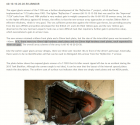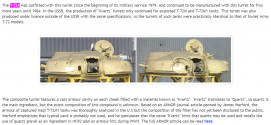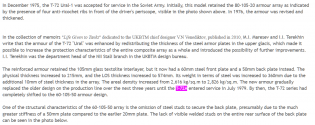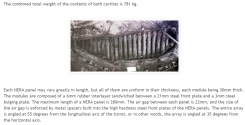I think the whole idea of putting the drone operator in the tank, as seen in the Panther, is kind of stupid in the first place. The drone operator(s) can be located significantly behind the front line. There is just no reason to put them inside the tank. The drone operators then mark targets which are served to the tank crew, or the tank crew request reconnaissance of targets. Similar to asking for air support.
You are using an out of date browser. It may not display this or other websites correctly.
You should upgrade or use an alternative browser.
You should upgrade or use an alternative browser.
PLA Next Generation Main Battle Tank
- Thread starter by78
- Start date
I believe that those drones that the drone operator in the tank would use are small expendable types which makes attrition losses more bearable compared to the loss of a large and expensive drone like a Reaper. Not to mention, those smaller drones fly much lower and are smaller so they are less likely to be detected on radar.I think the whole idea of putting the drone operator in the tank, as seen in the Panther, is kind of stupid in the first place. The drone operator(s) can be located significantly behind the front line. There is just no reason to put them inside the tank. The drone operators then mark targets which are served to the tank crew, or the tank crew request reconnaissance of targets. Similar to asking for air support.
Exactly. We have multiple footage of tanks guided by drones in Ukraine and none of the tank carry a drone operator. China can go a step further and live feed the drone view directly into crew's helmet.I think the whole idea of putting the drone operator in the tank, as seen in the Panther, is kind of stupid in the first place. The drone operator(s) can be located significantly behind the front line. There is just no reason to put them inside the tank. The drone operators then mark targets which are served to the tank crew, or the tank crew request reconnaissance of targets. Similar to asking for air support.
No one said that the unit would be losing that manpower either. For example, the French when switching to the Leclerc went from 4 to 3 men crews. That former 4th crewman became a maintenance specialist still attached to the unit but traveling in separated support vehicles. Same thing would happen here with the added advantage that you have less men exposed to enemy fire, and the tank being lighter of course. The real question regarding the viability of 2 man crews is the state of development of automatization of tank functions, we have Chinese articles covering that aspect in this very thread.2 man crew is a bad idea. There is so much to do on an armoured vehicle apart from operating it in action. Also, with a 3 man crew, you can lose one to injury and still operate it at a basic level.
Yes aware of what the French do, but that support vehicle needs to have the same protection and mobility of the tank it is supporting. Also, I don't think people here understand all the tasks of an armoured vehicle crewman outside of actual combat but on operations. Even when the vehicle is operating well.No one said that the unit would be losing that manpower either. For example, the French when switching to the Leclerc went from 4 to 3 men crews. That former 4th crewman became a maintenance specialist still attached to the unit but traveling in separated support vehicles. Same thing would happen here with the added advantage that you have less men exposed to enemy fire, and the tank being lighter of course. The real question regarding the viability of 2 man crews is the state of development of automatization of tank functions, we have Chinese articles covering that aspect in this very thread.
I still have a hard time imagining how automation can replace the workload of a 3rd crewman. Of course, the driver's role should be focused on driving. And certainly, you can replace the loader with a mechanical loader. That leaves the commander with... literally everything else, the most important roles being commanding the tank, aiming the gun and spotting enemies.
With a bit of imagination, I can see how automation can spot enemies via a series of sophisticated sensors, picking out infantry and tanks and showing them on a videogame-like HUD. With all these clips showing how advanced surveillance AI has become in China, I can absolutely see this system working out. Still, ideally, you want a commander that's on the lookout for the whole battlefield situation, rather than tunnel vision himself in a gunner role.
There's also the communication aspect. Now I've never operated in a tank, but I served as a signal op, and many of our folks also trained as gunners on IFVs, where they fulfilled both the role of gunner and radio operator. I would imagine a similar separation of tasks also exists onboard MBT. Comms doesn't feel like something you can leave to automation either - unless the driver take over that role since he's now seemingly sitting next to the commander?
Also, a lot of people here also mentions that 2 crew is the minimum to operate a tank, and one should have an extra crew on board if not just to keep the machine operable in an emergency - actually, I can see this MBT being operable by even just 1 crew, not too dissimilar to the Strv 103, if they duplicate controls for both crew members.
But still, as others stated 2 man crew just feels lacking even in the modern battlefield. I look at western prototypes for their 4th gen, where their 4th crewman now either operates an autogun turret (useful against helicopters or drones possibly) or controls a drone of some sort, and it feels like there's definitively potential there.
With a bit of imagination, I can see how automation can spot enemies via a series of sophisticated sensors, picking out infantry and tanks and showing them on a videogame-like HUD. With all these clips showing how advanced surveillance AI has become in China, I can absolutely see this system working out. Still, ideally, you want a commander that's on the lookout for the whole battlefield situation, rather than tunnel vision himself in a gunner role.
There's also the communication aspect. Now I've never operated in a tank, but I served as a signal op, and many of our folks also trained as gunners on IFVs, where they fulfilled both the role of gunner and radio operator. I would imagine a similar separation of tasks also exists onboard MBT. Comms doesn't feel like something you can leave to automation either - unless the driver take over that role since he's now seemingly sitting next to the commander?
Also, a lot of people here also mentions that 2 crew is the minimum to operate a tank, and one should have an extra crew on board if not just to keep the machine operable in an emergency - actually, I can see this MBT being operable by even just 1 crew, not too dissimilar to the Strv 103, if they duplicate controls for both crew members.
But still, as others stated 2 man crew just feels lacking even in the modern battlefield. I look at western prototypes for their 4th gen, where their 4th crewman now either operates an autogun turret (useful against helicopters or drones possibly) or controls a drone of some sort, and it feels like there's definitively potential there.
No, it doesn´t since its not exposed to the same threats and its always relatively far from the frontline. The French just use APCs.Yes aware of what the French do, but that support vehicle needs to have the same protection and mobility of the tank it is supporting. Also, I don't think people here understand all the tasks of an armoured vehicle crewman outside of actual combat but on operations. Even when the vehicle is operating well.
Look for some articles in this thread, close to the first pages. The concept here is that AI replaces mainly the gunner. The system searches for probable targets, hands them over to the commander for identification confirmation and fire authorization and the system does the rest.I still have a hard time imagining how automation can replace the workload of a 3rd crewman.
Thats my thoughts as well. This is a Chinese Armata style tank.
There is no "Armata style tank". Armata is the name of a common platform for a family of medium and heavy armoured vehicles.
The tank is T-14 and both its layout and engine are not determined by the platform. You can just as easily build an "Abrams" or "Leclerc" using Armata and power it with a gas turbine. So to be correct the concept of the MBT with a single crew capsule at the front is a "T-14 style tank".
And therefore it is extremely unlikely that China would follow that concept because T-14 is a horrible dysfunctional design that could only be conceived by someone who didn't know what tank crews do and didn't care to know. And it was.
Armata was conceived under Anatoly Serdyukov who had no military experience, and came from the new "private enterprise" generations within the industry. This is where all the new designs came from: Armata, Kurganets, Bumerang, Koalistiya etc.
Shortly after the tank was shown on the victory day parade (soon to be a decade ago!) there were rumours among Russian milbloggers that the Russian army rejected it after practical tests on multiple grounds - not just technical but also training, maintenance and tactical - but political pressures and lack of alternatives meant that the program was formally continued. The industry shills who wanted new design to increase revenue and profits - at the time Russia was modernising T-72s on the cheap using stored hulls to cut cost - blamed it on the engine but there was nothing preventing an older engine being used as an interim solution. The initial engine for T-14 had the same power as the latest V92 so it could easily be replaced due to the larger size of the hull.
The problem was that the entire general design of the tank was a failure and after Serdyukov was replaced by Shoigu the army had too much influence in the ministry to be forced to accept something it didn't want. This is why T-90M is being produced.
China uses an outdated ex-Soviet hull and mechanical design in its tanks. They're simply developing something better because it's been 40 years since NATO 3gens were fielded and they are the latest generation. The only tank that is not part of 3gen is T-14 and it's a failure.
We know China is testing a 2 man crew set up compensate with automation and data link.
This is done to develop knowledge - a practical experiment, not a guaranteed direction of development.
Also it's to develop backup systems so tanks with crew loss do not suffer loss of combat function. Sometimes one tank staying in the fight with 50% of crew alive for 1-2 hours is what's necessary for everyone else to get out alive.
I think the idea is overly stacking armor is insufficient for modern battlefield. There are certain threats that more armor will not help protect: guided artillery, top attack atgm, non-line of sight anti tank weapons, drones carry heavy atgm you cannot detect... Instead of overprepare for those just protect yourself against other direct fires and portable anti tank weapons.
Again: in Ukraine combat losses of armoured vehicles are caused by:
- 70% - mines
- 20% - artillery
- 10% - all other means combined including ATGMs, drones and tank-on-tank combat.
A vehicle that was disabled by a mine and killed by artillery or other means is classified under "mines".
It is impossible to design a vehicle survivable against direct hit from 122mm or 155mm guided artillery shell, and those will become more widespread in the future.
Similarly it is impossible to design a vehicle survivable to 155mm HE-FRAG detonation at close distance because fragments have such energy that unless it's proper heavy armour they will damage the engine, transmission, hydraulics, other mechanical parts and injure or kill the crew. You can design the vehicle that is more survivable in relative terms by replacing hydraulics with electromechanical systems, put a hybrid engine with fewer volumetric parts etc but that's all applicable to mobile vehicles. As soon as mobility is lost the vehicle must be evacuated.
All the propaganda videos of drone strikes are propaganda. How many tanks genuinely killed by drones have you seen out of 3000+ lost by both sides? How many during the current static phase?
So tank design focuses on two aspects:
- avoiding detection & detecting enemy first
- survival against direct fires
Takes the weight saved and obtain strategic mobility.
At present strategic mobility is an issue for the US and not for China.
Of the three logistical domains air is most problematic, sea is most vulnerable and land is by far most enduring and economical. In Asia the US must rely on air and sea because it has no deep land buffer like in Europe with dense logistical networks and an existing industrial base.
Look up the logistics of transporting and sustaining an ABCT in theater vs IBCT and you'll see why it's such a problem and ABCT can't work without tanks because it literally is a tank formation with infantry for support. This is why sequestration in 2013 cut infantry in ABCT but not tanks. ABCT is tanks. The rest of US Army is infantry.
Doctrine is a confusing dry language with hidden meaning that you learn through practice. Once you have learnt it however you see that what it really talks about is often the opposite of what you thought before you acquired necessary knowledge.
If the tank is hit, make sure crews survive. If crews are lost, that is just 2 crews.
Tanks with crew of 2 will be lost at a much higher rate than tanks with crews of 4 and this is straight from how tank crews actually operate.
A few years ago the US Army organised a workshop with actual tankers and the conclusions heavily favoured 4 man crews.
A tank is like a land ship and it works more like a land ship. Ideally you should be able to move around in it. This is why every tanker I spoke to prefers Leopard 2 or Abrams to Soviet T-tanks or Korean K2 because of space and ergonomics.
Poland as of now has used:
- T-72
- domestic upgrade PT-91
- Leopard 2A4, A5 and upgraded PL
- M1A1 and A2
- K2
While there are individual preferences between the two depending on who is talking (logistician, engineer, tanker etc) everyone agrees that this MBT concept is optimal for sustainment of combat potential in the field. And that's the metric that wins the combat.
Furthermore the enemy of China is no longer Soviet Union that fields powerful tanks on open field.
You have no idea what tanks are used for and how. E.g. urban warfare is a surprising twist on tank use because many thought it would be an equalizer, especially after Grozny, but MBT is more relevant there than in the open field.
Also why do you assume that they would not be used in Central Asia or along the narrow populated strip in Russian Siberia? Why wouldn't they be used in a hypothetical contest between India or Pakistan?
As soon as China develops tanks that are limited in performance by being tailored to specific theaters, the pressure will shift to another theater.
There have also been recent articles from the US how they are looking at a lighter and more mobile future main battle tank to succeed the M1 family (likely including currently in development variants) in tactical, operational and strategic ways, as well as being more survivable.
That's just industry shills pushing for more funding. It's going to be a repeat of Future Combat Systems. It's also a response to this:
The product of that particular evolution won't be a "tank" but effectively a collaborative system of unmanned ground combat vehicles with humans in decision loop.
The part that most people misunderstand is that tanks are not necessary. They are a particular tool for a particular set of conditions the primary being breakthrough exploitation which occurs in very specific conditions. Tanks are not necessary but very very good for that particular maneuver.
However as the information flow in battle-space increases putting several functions into one hull is becoming less than optimal.
Tanks exist because they shelter crews capable of a given amount of actions autonomously.
Once those actions are equally or better performed by extensive distributed systems tanks will become obsolete. Then and only then.
But once that happens you can't really talk about a "tank". And this is why in the clip you have "main ground combat system" and not "next generation tank". Whatever will happen the manned component will always have the strongest armour because it will be the decision node and therefore a priority target.
Last edited:
Fake assumption and wrong conclusion.
Soviet pioneered composite armor and it is present in base T-72 and earlier T-64. Later variants has multiple layers of composite.
Not to be rude but that was very clueless and likely based on propaganda. Whatever Chinese composite layout today and future only get better than 70s Soviet Union.
You are calling me clueless, but you don't even read the contents of your own link? Are your own sources propaganda?

Early Soviet models had sandwiches of steel and polyurethane, later on the polyurethane was replaced with textolite. Some models, like some later T-72As and T-72Bs (see above), was non-composite steel plates and air gaps.
NERA was largely a Western innovation, which takes up much more volume but also offers better protection. Maybe go back and read my previous post again. The huge NERA arrays in the turret of an M1 Abrams necessitates the large hull, hence the weight. Of course, the bustle ammo rack is also a reason for the very large turret.
Some of the newer Russian tanks (T-72B 1989, T72BA, T-72B3, T-90 1993) have limited application of NERA, but not in thick arrays mounted at high obliquity like in NATO 60-ton class MBTs.
Yes I called you clueless and I still think you are clueless. I read my sources thoroughly. You on the other hand, did not. As a result I will point out exactly where you are wrong according to my source in order to get my point across.You are calling me clueless, but you don't even read the contents of your own link? Are your own sources propaganda?
You claim T-72A did not have composites are all, only "steel an air gaps". This is false. You provided me of a screenshot of section on T-72B hull armor instead.It's not as straightforward as up-armoring a 45-ton MBT to have the same protection as a 60-ton MBT. Physics works the same everywhere and if you try to save 15 tons, sacrifices have to be made.
The fundamental difference between today's 45-50 ton Soviet MBTs and 60-65 ton NATO MBTs is armor layout. The Soviet T-series have a very basic composite layout, usually several layers of steel and other materials like Textolite arranged in a simple sandwich. In some models (e.g. T-72A) there are no composites at all, just layers of high-hardness steel with air spacing.
Turret using composite:

T-72A use Kurvaz filler for turret since the start. This is a type of high hardness ceramic block. You likely confused with T-72 Ural series prior to T-72A, which uses a cast turret.
Hull:

T-72A use same glass textolite interlayer not "air spacing" like you claimed. T-72B uses the space + steel layout, but only on the hull. In the turret it uses NERA arrays.
It's not as straightforward as up-armoring a 45-ton MBT to have the same protection as a 60-ton MBT. Physics works the same everywhere and if you try to save 15 tons, sacrifices have to be made.
The fundamental difference between today's 45-50 ton Soviet MBTs and 60-65 ton NATO MBTs is armor layout. The Soviet T-series have a very basic composite layout, usually several layers of steel and other materials like Textolite arranged in a simple sandwich. In some models (e.g. T-72A) there are no composites at all, just layers of high-hardness steel with air spacing.
On the other hand, NATO MBTs like the Abrams have full-scale NERA arrays built into the hull, which have many steel-rubber-steel sandwiches arranged in a complex geometry. The advantage is much better base armor protection compared to Soviet tanks. The downsides are that it takes much more volume, is more difficult to repair, and due to the resulting huge turrets which also contain a bustle ammo rack, necessitates a very large hull, adding lots of mass.
Next up you generalize all Soviet T-series have very basic layout, and as if no NERA arrays found on western MBT. This is again false. Soviet has been using NERA since 1980s, seen in T-80U and T-72B turrets. They use them in arrays unlike the simple sandwich you claimed. Simple sandwich NERA was only used on T-55AM and T-62M as add on armor. T-72 series use arrays.


As for why not on the hull, NERA was found to be less effective vs long rod penetrator vs KE than air gaps + steel. While it was better vs HEAT, Soviet tanks already had ERA installed for that. In other words western tanks using NERA on the hull as opposed to ERA panels is not 'better protection'. Abrams's lower hull was notoriously weak vs KE until the recent upgrades. I could go on about your errors on geometry(bulging plate vs reflecting plate) too but that will derail the thread. Better to read the source I provided instead.
------------------
Back to the main topic, NERA array layout will not be a weight constraint for future Chinese tanks. China already incorporated NERA array on current tanks while still kept the compactness. The main contributor of the mass is mainly layout.
